 It’s always important to have fun with our children. New experiences, new people and new surroundings can seem overwhelming to little ones. Read on for ways to make a trip to the dentist fun for your child and for you!
It’s always important to have fun with our children. New experiences, new people and new surroundings can seem overwhelming to little ones. Read on for ways to make a trip to the dentist fun for your child and for you!
- Explain the Profession
Treat each experience at our office as a chance to educate your child. Look for way to discuss how different adults have different professions. Explain to your child that a dentist is a doctor, who treats and cares for teeth. Watch your child’s initial fear of the unknown transform into curiosity.
- Explain Why
Children as young as 3 can value an explanation. Whether imparting the importance of sunscreen or a winter jacket, children often understand far more than most realize. Explain the importance of visits to the dentist as well as daily brushing and flossing. This will help them to enjoy their visits as they understand the role we play in their healthy body and smile.
- Make the Visit Fun
Our dental team will always greet you and your child with a smile. We understand the importance of making each appointment enjoyable. With your assistance, we can create a fun and educational experience at each and every visit. This will establish the foundation for a lifetime of optimal oral health for your child.
- Reward and Applaud
When your child leaves with a smile, make sure he or she is given attention for excellent behavior at our office. Spending special one-on-one time with your child after his or her appointment can create a routine that both you and your child will enjoy.
Please know your child’s oral and overall health is important to us. Call us any time with questions or concerns. We’re here for you.

 Children losing their first tooth is an exciting stage in life. They often run to you as soon as their tooth falls out asking if the Tooth Fairy will visit them at night. Most children know about the Tooth Fairy, but many people don’t know where or when this tradition started. The concept surrounding lost baby teeth has been around for centuries. Below we have shared common historical traditions that have helped evolve the Tooth Fairy into the tradition that it is today.
Children losing their first tooth is an exciting stage in life. They often run to you as soon as their tooth falls out asking if the Tooth Fairy will visit them at night. Most children know about the Tooth Fairy, but many people don’t know where or when this tradition started. The concept surrounding lost baby teeth has been around for centuries. Below we have shared common historical traditions that have helped evolve the Tooth Fairy into the tradition that it is today. Braces create a beautiful, straight smile, but how do you maintain these results after treatment? Your final orthodontic results depend on your retainer. Retainers help maintain the position of straighten teeth, so be sure to follow up with us for additional treatment after your braces have been removed. Read the information below to learn more about retainers and how to care for them at home.
Braces create a beautiful, straight smile, but how do you maintain these results after treatment? Your final orthodontic results depend on your retainer. Retainers help maintain the position of straighten teeth, so be sure to follow up with us for additional treatment after your braces have been removed. Read the information below to learn more about retainers and how to care for them at home. A happy smile is a healthy smile! There are a number of steps you can take to keep your smile healthy by reducing your risk of developing tooth decay. Here are a few suggestions from our team.
A happy smile is a healthy smile! There are a number of steps you can take to keep your smile healthy by reducing your risk of developing tooth decay. Here are a few suggestions from our team. Your baby’s first teeth developing can be a difficult experience for both you and your child. Most teeth begin to appear as early as 3 moths to 1 year old. This process can be uncomfortable and cause sleepless nights. However, there are things you can do to keep your toddler less irritable while they are teething.
Your baby’s first teeth developing can be a difficult experience for both you and your child. Most teeth begin to appear as early as 3 moths to 1 year old. This process can be uncomfortable and cause sleepless nights. However, there are things you can do to keep your toddler less irritable while they are teething. As a parent, it’s important to model good behaviors to your children. From being courteous to cleaning up after themselves, your child learns how to be responsible from you. It can be difficult to get your child to practice good oral care unsupervised, however the long-term benefits of an early start to good oral hygiene are worth the effort. Below are some tips to help you make practicing good oral health a fun part of your child’s daily routine, rather than something you have to fight over every day. Contact our dental team today to learn more or to schedule your child’s next dental examination and cleaning.
As a parent, it’s important to model good behaviors to your children. From being courteous to cleaning up after themselves, your child learns how to be responsible from you. It can be difficult to get your child to practice good oral care unsupervised, however the long-term benefits of an early start to good oral hygiene are worth the effort. Below are some tips to help you make practicing good oral health a fun part of your child’s daily routine, rather than something you have to fight over every day. Contact our dental team today to learn more or to schedule your child’s next dental examination and cleaning. Did you know that tooth decay is the single largest cause of school absences? The longer decay goes untreated, the worse it gets. Not only can this mean costlier expenses for you, but it also jeopardizes your child’s oral health and education. You can help your child have a healthy, happy smile by taking a few steps to defend against tooth decay. Here are three steps you can take at home.
Did you know that tooth decay is the single largest cause of school absences? The longer decay goes untreated, the worse it gets. Not only can this mean costlier expenses for you, but it also jeopardizes your child’s oral health and education. You can help your child have a healthy, happy smile by taking a few steps to defend against tooth decay. Here are three steps you can take at home. Tooth decay in infants and toddlers is often referred to as “baby bottle” tooth decay. This type of tooth decay is often caused by bacteria shared by the primary caregiver or by a lack of proper oral hygiene. However, the most common cause is frequent and prolonged exposure to drinks containing sugar, especially in the baby’s bottle.
Tooth decay in infants and toddlers is often referred to as “baby bottle” tooth decay. This type of tooth decay is often caused by bacteria shared by the primary caregiver or by a lack of proper oral hygiene. However, the most common cause is frequent and prolonged exposure to drinks containing sugar, especially in the baby’s bottle. Oral health is important at every stage in life. Just because your children are going to lose their primary (baby) teeth eventually doesn’t mean that we can ignore the importance of dental care. Tooth decay can be painful and uncomfortable to treat. To protect your child’s smile, it is vital to understand optimal preventive care.
Oral health is important at every stage in life. Just because your children are going to lose their primary (baby) teeth eventually doesn’t mean that we can ignore the importance of dental care. Tooth decay can be painful and uncomfortable to treat. To protect your child’s smile, it is vital to understand optimal preventive care.
 Hoover Dentist
Hoover Dentist





